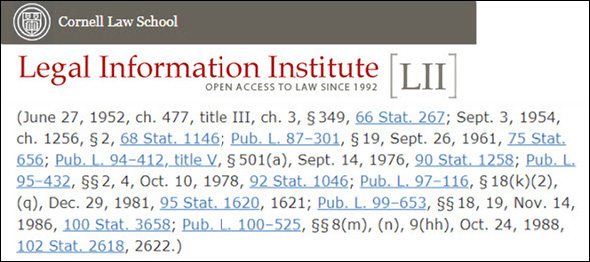… legally speaking …
Sometimes just knowing what the law is, isn’t enough.
Sometime what we need to know is how and when the law changed.
After yesterday’s blog post about expatriation and some of the records created by repatriation,1 a reader noted that a college roommate had been born in the United States to Canadian parents and, when she turned 21, had had to swear allegiance to one country and permanently relinquish her citizenship in the other.
The reader noted that requirement seemed to be different from the current version of the law. What the reader wasn’t clear on was whether the law had changed or whether the State Department’s interpretation of the law had changed.2
It was the law. Today, the very first words of the section are: “A person who is a national of the United States whether by birth or naturalization, shall lose his nationality by voluntarily performing any of the following acts with the intention of relinquishing United States nationality…” and then it goes on to say what those acts are.3 The highlighted phrase was added by Pub. L. 99–653, 14 November 1986 as reflected at 100 Stat. 3658.4
And no… no matter how much The Legal Genealogist may know about the law … that’s not something produced out of memory.
It’s part of the legislative history of that particular section of the United States Code, and it’s actually something that — in some cases at least — can be pretty easy to find.
Here’s the deal: many of our current statutes — both federal and state — have what are called historical notes. Once you find a copy of the law somewhere online, or in a published volume, look carefully to see if there’s a note down at the bottom or over in the margin that sets out the source of and/or changes in the particular law.
For example, when I wanted to know whether this particular part of the law had changed, I entered the legal reference to the law (8 U.S.C. §1481) into my favorite search engine and then chose my absolute favorite legal resource — Cornell’s Legal Information Institute — to look at that law online. (I could have chosen most any online source for this, including the version on the website called GovInfo.gov, a service of the Government Publishing Office, or the one on the website of the Office of the Law Revision Counsel of the U.S. House of Representatives. Your choice here.)
Then I scrolled all the way down to the bottom and found this:

That’s the kind of historical note I’m talking about. It tells us:
• The law was adopted in 1952 — and checking the statutory reference we see it was part of the Immigration and Nationality Act of 1952.5
• It’s been amended seven times since then, in 1954, 1961, 1976, 1978, 1981, 1986 and 1988.
Each of those changes has a hyperlink to other materials that show us the source. I chose to work backwards through the changes, clicked on the link for the Federal Digital System so I could read the amendment, and found that the most recent change to §1481, in 1988, was a technical correction that had nothing to do with this particular phrase.6
The second change, working backwards, was in 1986, and that’s where I hit paydirt.
A total of four clicks — one each on the hotlinks to the resources and one more each to the specific resources that have the actual copies of the amendments — and we know exactly when this language came into the statute.
No, it won’t always be that easy. Some online statutes don’t have hyperlinks in the historical notes to sources that make it easy to read the amendments. Some online statutes don’t have historical notes at all.
But when the historical notes are there, we can use ’em whenever we find the law is changing gears.
Cite/link to this post: Judy G. Russell, “Changing gears,” The Legal Genealogist, posted 8 Feb 2019 (https://www.legalgenealogist.com/blog : accessed (date)).
SOURCES
- Judy G. Russell, “2019 alphabet soup: E is really for…,” The Legal Genealogist, posted 7 Feb 2019 (https://www.legalgenealogist.com/blog : accessed 8 Feb 2019). ↩
- Ibid., comment posted by G., 8 Feb 2019. ↩
- 8 U.S.C. §1481 (emphasis added). ↩
- “An Act to amend the Immigration and Nationality Act, and for other purposes,” 100 Stat. 3655, 3658 (14 Nov 1986). ↩
- “An Act to revise the laws relating to immigration, naturalization, and nationality; and for other purposes,” 66 Stat. 163 (27 June 1952). ↩
- See “An Act to amend the Immigration and Nationality Act to make technical corrections in immigration-related laws,” 102 Stat. 2618, 2622 (24 Oct 1988). ↩



Thanks for finding the explanation, Judy. I knew there had to be one somewhere. I didn’t realize the change took place ss far back as the 1980s. It must have happened shortly after my widowed aunt (a naturalized US citizen born in Canada) forced to renounce her US citizenship and apply for repatriation in order to move back to Canada to be near her family. She’d was so proud of being an American that it just broke her heart.